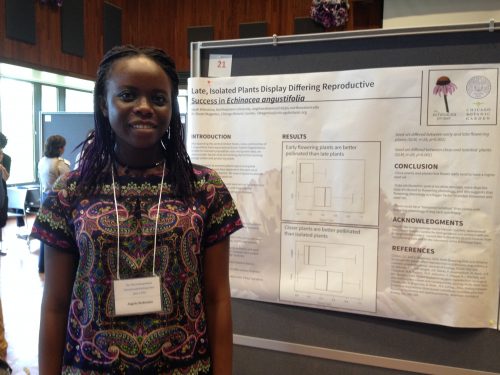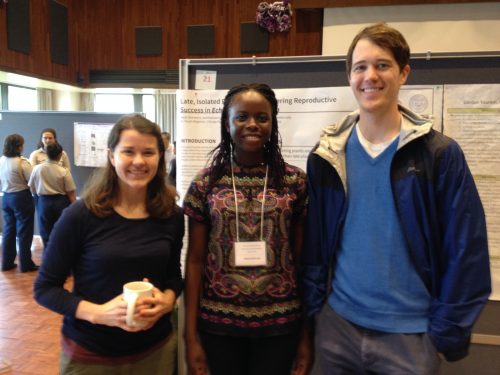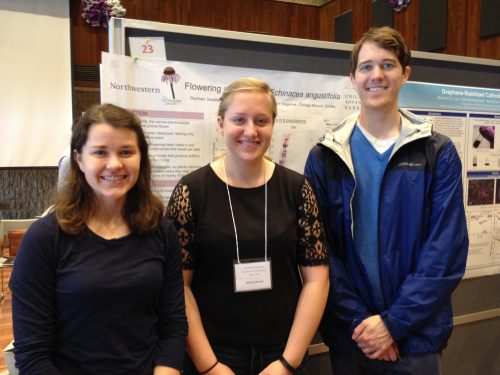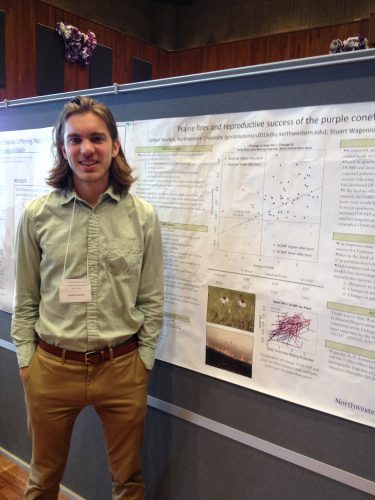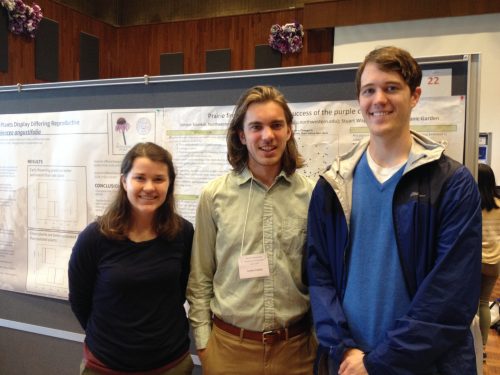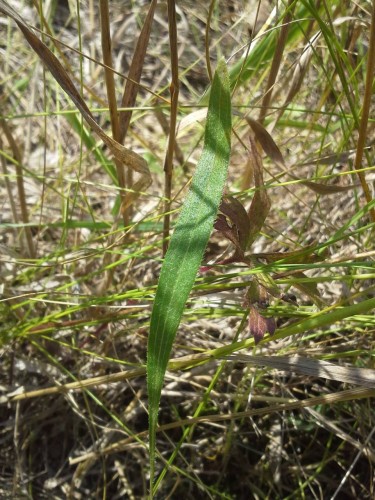We were curious about the average sizes of our various remnant populations so I did some quick calculations and created this csv. As you can see, landfill is quite large with a median of 315 individuals found per year, whereas sites like dog and mapp are tiny, with only 3 plants found per year. At dog, to the best of our knowledge, there are only 3 Echinacea to be found, so we have regularly gathered demographic info on all of them. It’s important to note that these numbers are preliminary, rough estimates. Sometimes we have to redo a site during the summer so there will be twice as many records (hence the right skewed means), most of the time we focus on only finding flowering plants, but in some years at certain sites (e.g. landfill in 2005 and 2007) we’ve attempted to find every single individual whether or not it was flowering. All that said, here are some histograms showing numbers of demography records at each site per year:
|
||||
|
Sarah presented her poster, “Late, Isolated Plants Display Differing Reproductive Success in Echinacea angustifolia” at the Northwestern Undergraduate Research and Arts Exposition. Here are some pictures from the event and her poster, which you can find here.
Rachael presented her poster, “Flowering schedules of Echinacea angustifolia” at the Northwestern Undergraduate Research and Arts Exposition. Here are some pictures from the event and her poster, which you can find here.
Gordon presented his poster, “Prairie fires and reproductive success of the purple coneflower” at the Northwestern Undergraduate Research and Arts Exposition. Here are some pictures from the event and his poster, which you can find here.
This past weekend, I attended the second, biannual Midwest Mathematical Biology Conference (MMBC) hosted at the University of Wisconsin La Crosse. There were a lot of great talks throughout the weekend including plenary speakers Dr. Louis Gross, Dr. Carina Curto, and Dr. Mark Craven. I learned a lot about mathematical biology, including a multitude of uses for differential equations and some great techniques in evolutionary computing. At the end of Saturday, there was a poster session that included 6 posters. After the poster session, most of the people at the conference went on a wonderful Mississippi River paddlewheel river boat replica and ate pizza. The next day we had more great talks, then a long drive back to Chicago. You can find my poster in its new home in the lab, or you can see it here. 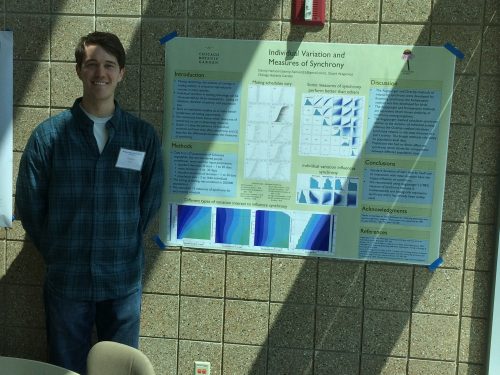 Standing with my poster in the atrium at UW Lacrosse 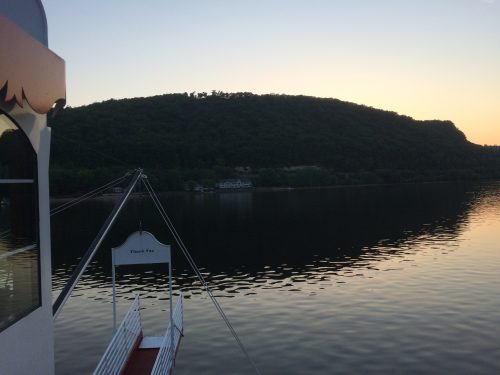 A beautiful view of the Mississippi River at sunset  My poster in its new lab location. In 2015, we continued to gather demographic information on Echinacea angustifolia in remnant prairie populations. We went to 32 remnant prairies ranging size from 1 flowering plant to 289 flowering plants. This year at our largest site, the Staffanson Prairie Preserve, we collected demographic information on 318 individual plants including 175 flowering plants. Across all the sites, we found 1561 flowering plants and visited a total of 1889 plants. For each plant that we visit, we record whether the plant is alive, whether the plant is flowering, and how many flowering heads it produces. We currently have former team member Lydia English and current team member Will Reed working on organizing the previous 20 years of data using methods that Stuart, Jared, and Gretel developed last year. So far we have organized data from 2010-2015 (years we used GPS units) in 10 sites and data for all 1995-2015 for Staffanson Prairie Preserve. Read previous posts about this experiment.
Start year: 1995 Location: more than 30 remnant prairies in and near Solem Township, Minnesota Overlaps with: fire and flowering at SPP, flowering phenology in remnants Products: Wagenius, S. 2006. Scale dependence of reproductive failure in fragmented Echinacea populations. Ecology 87:931-941. PDF | Supplemental Material Project “demap” – organized survey, demography, and phenology data. In 2015, we continued to assess survival and growth of plants that were found as seedlings in the springs of 2007 to 2013. This year we went to 13 sites and 142 parental plants. We found a total of 162 former seedlings with 48 of those at the site East Elk Lake Road. At first, the task of reading the maps and triangulating plant positions was hard for the team. We were worried we weren’t going to finish by the end of the field season. But, once we got the hang of it, we sped through with ease. Read other posts about this experiment.
Start year: 2007 Location: Remnant prairies in central Minnesota Overlaps with: demographic census in remnants Products: Check the flog for preliminary results and annual reports. Though Stuart, Gretel, and Amy will be headed to Minnesota for the summer, our wonderful team of volunteers will still be here in Illinois working hard. We’ve used a couple systems to measure progress in the past few years but we’re going to make a simplified version for the summer before completely redoing our lab workflow visualization. We wanted to give our progress boards a proper send off before replacing them with a simpler summer-oriented progress board. More details to come! 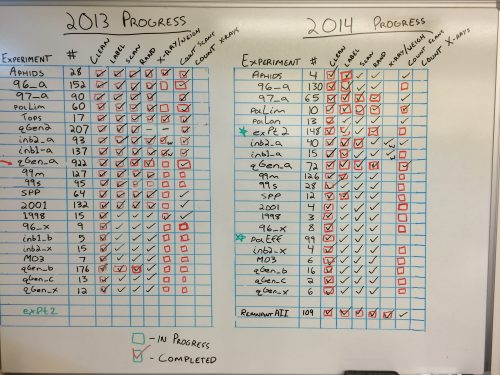 The progress board before being erased. 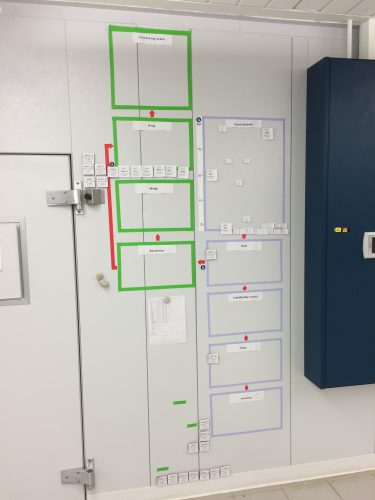 The progress wall before tape removal In 2015, we continued an experiment that investigates hybridization between the native Echinacea angustifolia and the unintentionally planted non-native E. pallida. This year, out the the 758 plants planted in spring 2014, 521 were still alive which is a survival rate of 68.7%. In the late summer of 2013, members of Team Echinacea collected heads from Echinacea angustifolia and Echinacea pallida from two nearby populations at Hegg Lake Wildlife Management Area. Unlike previous experiments, we performed no artificial crosses. This allows us to determine if hybridization is occurring naturally. In the winter of 2014, Lydia English germinated seeds from these heads. In the spring, Lydia and Stuart planted 758 seedlings at Hegg Lake WMA near experimental plot 7. We took fitness measurements, such as number of rosettes and leaf lengths, this year. In addition to the experimental plot, we collected heads and tissue samples from 28 E. angustifolia that were near the restoration with E. pallida. We have not yet done any analysis on these plants but we are hoping to determine if hybridization in continuing. Read more posts about this experiment here. 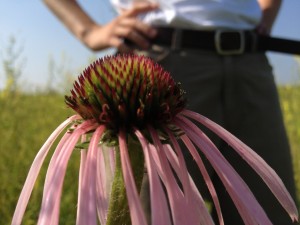 Echinacea Pallida at Hegg Lake Start year: 2014 Location: Hegg Lake Wildlife Management Area – Experimental plot 9
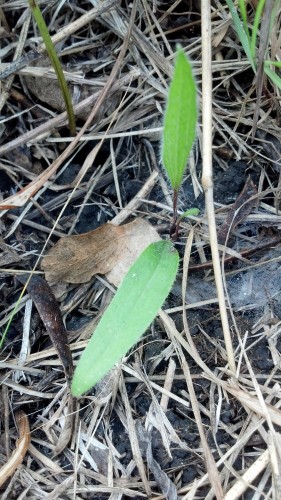 A hybrid at Hegg Lake In 2015, we continued an experiment that quantifies fitness of Echinacea angustifolia x pallida hybrids and pure-strain plants. Out of the the original 522 plants, 323 were still alive in 2015, which is a survival rate of 62%. The mean leaf length of these plants was roughly 11.7 cm. Stuart planted the 522 seedlings at Hegg Lake WMA in spring 2013. The seedlings result from hand reciprocal crosses conducted by Shona Sanford-Long during the summer of 2012. Read more posts about this experiment here. Start year: 2013 Location: Hegg Lake Wildlife Management Area – Experimental plot 7 |
||||
|
© 2025 The Echinacea Project - All Rights Reserved - Log in Powered by WordPress & Atahualpa |
||||

